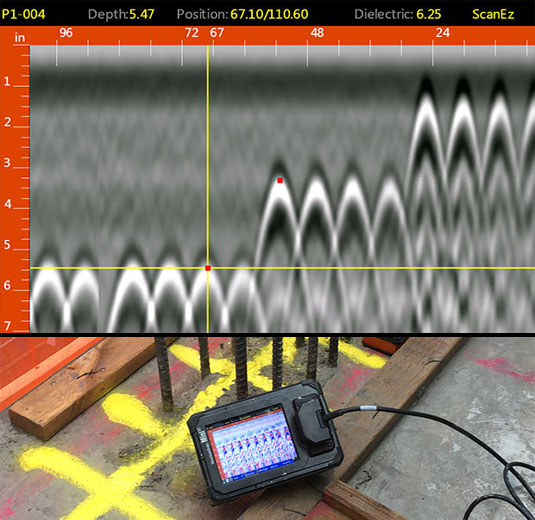The Significance of Specialist Concrete Scanning Services
The Significance of Specialist Concrete Scanning Services
Blog Article
Elevate Your Construction Refine With the Strategic Insights of Concrete Scanning for Improved Efficiency
In the world of contemporary building and construction practices, the pursuit for performance and accuracy is vital. Welcoming cutting-edge technologies has come to be a keystone for achieving these objectives. One such technology that has actually changed the construction industry is concrete scanning. By taking advantage of the strategic insights supplied by concrete scanning, building professionals can unlock a realm of improved performance and streamlined processes. The implications of incorporating concrete scanning go far beyond surface-level benefits, providing a profound influence on job outcomes.

Benefits of Concrete Scanning
Enhancing task effectiveness and security, concrete scanning offers a non-destructive technique for identifying surprise things within concrete frameworks. By making use of technologies such as ground-penetrating radar (GPR) and concrete x-ray imaging, building teams can precisely locate rebar, post-tension cables, electrical conduits, and other blockages prior to boring, reducing, or coring into concrete.
The advantages of concrete scanning are various. Building and construction websites can be complicated settings, and knowing what exists beneath the surface can protect against injuries and mishaps.
Additionally, concrete scanning promotes general task efficiency by avoiding and enhancing process rework. By determining possible issues at an early stage, groups can readjust their strategies proactively, saving time and sources in the lengthy run. Fundamentally, the adoption of concrete scanning technologies is a tactical financial investment that pays dividends in terms of safety and security, performance, and cost-effectiveness.
Modern Technology Combination for Performance
Concrete scanning's capacity to simplify workflows and enhance project efficiency can be additional maximized via critical assimilation of advanced modern technologies. By including Structure Details Modeling (BIM) software program into concrete scanning processes, construction teams can attain a higher degree of accuracy and sychronisation. BIM enables the production of 3D versions that offer thorough understandings into the task, allowing much better decision-making and minimizing the likelihood of mistakes. Furthermore, the integration of Enhanced Fact (AR) modern technology with concrete scanning can boost on-site visualization, allowing task supervisors and workers to overlay electronic details onto the physical environment in actual time. This can help with more precise positioning of elements and enhance communication among team members. The use of drones for airborne studies in combination with concrete scanning can quicken data collection and analysis, making it possible for quicker decision-making and development monitoring. In general, the tactical assimilation of these innovations can considerably enhance effectiveness and productivity in building and construction projects.
Preventing Expensive Mistakes
Exactly how can meticulous attention to information throughout concrete scanning processes assist building teams in stopping pricey errors? By making use of advanced scanning modern technologies such as Ground Permeating look at more info Radar (GPR) and electro-magnetic induction, construction teams can properly find rebar, utilities, spaces, and other blockages within concrete frameworks. In addition, concrete scanning helps in making sure structural stability by recognizing weak points or flaws in the concrete early on, enabling for prompt repairs and adjustments.
Enhancing Task Monitoring
Precise focus to information throughout concrete scanning processes not only assists in staying clear of costly mistakes yet also lays a solid foundation for efficient task management in building ventures. By incorporating concrete scanning innovation into project administration techniques, building groups can streamline workflows, boost communication, and make sure that jobs stay on track.
Concrete scanning supplies useful understandings right into the architectural stability of existing components, allowing project managers to make enlightened choices relating to style modifications or construction sequences. This positive technique lessens the danger of unexpected delays or remodel, ultimately saving time and sources. In addition, the data acquired from concrete scanning can be integrated right into Structure Info Modeling (BIM) systems, making it possible for real-time cooperation and sychronisation amongst numerous stakeholders.
Moreover, concrete scanning aids job managers recognize potential hazards or obstacles before they rise into larger concerns, promoting a much safer job atmosphere for all entailed. With improved exposure and precision supplied by concrete scanning technology, task supervisors can successfully plan, check, and carry out building and construction tasks with greater performance and confidence.
Making Best Use Of Performance
One essential element of making the most of performance is through the adoption of concrete scanning technology. By utilizing ground-penetrating radar (GPR) and various other scanning methods, building teams can precisely find rebar, conduits, and other subsurface elements, reducing the risk of costly errors and delays during excavation and boring.
Moreover, welcoming Building you could try here Information Modeling (BIM) software program can substantially boost performance by developing thorough 3D designs that boost task visualization and control amongst different professions. BIM permits far better clash discovery, allowing issues to be determined and fixed before construction also starts, conserving time and resources in the lengthy run.
Implementing a lean building and construction strategy, which concentrates on eliminating waste and optimizing efficiency throughout all project phases, is one more reliable approach for optimizing efficiency. By fostering cooperation, interaction, and continuous improvement, building and construction teams can work a lot more cohesively in the direction of attaining project goals in a productive and structured way.
Final Thought
To conclude, the critical implementation of concrete scanning in the construction Find Out More procedure offers various advantages, consisting of boosted performance, expense financial savings, enhanced project administration, and boosted productivity. By integrating this innovation, building teams can stay clear of costly mistakes, improve their procedures, and optimize their total project output. Concrete scanning is a beneficial tool that can raise the building procedure and cause more successful and rewarding outcomes.

Report this page